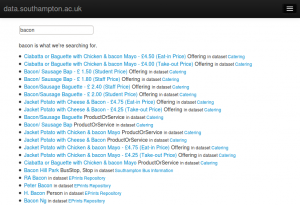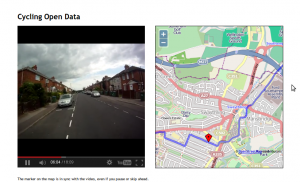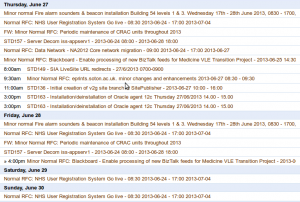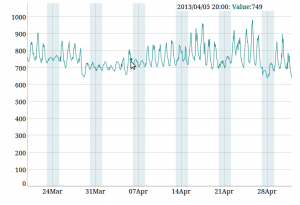Events
Information (about the) Blackout
November 13, 2014
by Christopher Gutteridge
UPDATED Friday 14th. See end of post for update about the plans.
Friday sees the 3rd annual University Blackout event where everybody is encouraged to turn off their electrical equipment so we can see how much energy is save. Later in the evening, a team of 250 volunteers scamper around offices turning off remaining monitors and computers unless they have a pre-approved excemption certificate taped to them.
Obviously the savings this makes are only a drop in the ocean, but the headline figure in the infographic is 6%. I was interested in how they got that number, as last year I ran a building-by-building analysis of energy use, based on the open data provided by their system for each main building. eg. http://data.southampton.ac.uk/building/59.html?energy
From the horse’s mouth
(..or do I mean horse’s meter?)
I was invited to go and see how the system all works, and wheree the data comes from. It’s a small team with many responsibilities and bits of the system are more aged than other, so they can’t do all things for all people. They are monitoring well over 100 buildings over many sites.
To give the value for a building they use a virtual meter which is a function on top of one or more real world meters. The function can add the values of several meters, and sometimes apply a fiddle factor for known errors. Metering is not a simple task at these scales and the sum of all the meters never quite adds up. Some of the issues include a misinstallation. This is rare. Suspiciously low readings set off ther analysist’s spidey-sense and physical investigation led to the issue being found and corrected.
There’s more subtle cases though. We apparently have some meters which measure differently, depending on warmth, and we have meters which measure hot water flow which get slowly clogged and the measurements alter until they are cleaned, but that involves shutting stuff down and can’t be done often. It’s not all meters that play up, but the ones that do need to be considered when drawing conclusions from data.
I should stress that these are our internal meters which we use to monitor our systems, not the meters that decide how much we pay.This year the plan for measuring the impact of the blackout event is to focus on the campus figure rather than by building. A keen reporter at SotonTab, the unofficial student news site, got someone to total up energy usage all the buildings over last year’s Blackout, but given the variation of meter performance it’s hard to trust this data. The margin of error is higher than the number we’re looking for. This year the provisional plan for the official figure is to use the main power consumption value for each campus rather than using sets of individual buildings.
A molehill, but a molehill on a mountain
One of the big concerns with the project, that I share with some other malcontents, is that it is a feel-good exercise which does nothing to address the real issues of energy reduction. What I was unaware of is all the other work already done and being done to waste less resources.

An electric heater. Imagine lots of them turned off.
The really big one I was aware of but never really thought about, which is the Combined Heat & Power system on Highfield Campus. What this does is uses gas to generate both electricity and heat for the campus, wasting less energy (and causing less carbom emissions) than getting electricity from the grid. We hope to soon start publishing the summary data, but the headline figure is about half-a-million quid a year saved, or to put it another way. Imagine several hundred 1000 Watt heaters all running full blast all day every day, year in, year out, and for no good reason. That’s about the amount of energy the CHP system is saving. It ain’t the most sexy thing about our university, but it’s something we can all feel a bit of pride in.
Another part of their job is to study the data and spot and investigate changes in the way each building uses energy and see if there are any things to be done about them.In the context of all of these big things already being done, it starts to make more sense why they are now working on higher-effort, lower reward tasks such as encouraging people to turn off unused stuff– they’ve already done much of the easier savings.
- More information on university carbon management projects
- Lots of data (sheets) about building energy efficiency
But what’s actually worth turning off?
Many years ago I used a little gadget to find out how much power all my electronic posessions drew when on, and when on standby still turned-on-at-the-plug. It helpped me understand where it was most useful to put effort into powering off and unpluging my stuff when not in use.
There were two main surprises…

Unfairly accused.
First of all, my phone charger, when the phone was not attached, used no mesurable amount of power, so I stopped bothering turning them off.
The other surprise was my data projector. It used 200W when projecting but that’s not that surprising, I knew it was a high-energy-use item. What shocked me was that it used 30W when on standby mode doing nothing at all. As a result I always made sure it got turned off at the mains.
Obviously your-milage-may-vary, but the university buys many standard items which are all very similar like computers, monitors, fans, etc. What we could start doing is checking their power use and standby-power-use, and label all the units of that exact type we deploy in office and lab space so that staff can make an informed as to where there’s value in bothering to turn things off.
But why isn’t all the data open?
There’s several reasons to this.
One is that the raw meter data has many caveats to interpretation, and I’ll agree that it’s hard to get people to read the tasting notes going along with open data. One idea I’ve had is to make the “citation URL” the document describing the data, so if you do anything with the data and “must attribute” the data creator, that attribution must be to the document warning of the known issues with the data.
Oh, and some of the meters log an error as “0” (zero) rather than NULL, so that’s not ideal for statistical analysis. This is what you end up having to deal with in pragmatic real-world data.
The other reason it’s hard to get at the raw data is that the only way to get it is via the system which collates it and that is 1996, the era of Spice Girls and Buffy the Vampire Slayer. it might be just a bit older than some of our current freshers.
So obvisously it’s very slow and klunky and as usual the project to replace it is taking longer than hoped.
Why don’t we ask the experts
I asked them why they didn’t make it available and they said (to my embarrassment) that they do, you just need to ask nicely and they’ll give a password to any member of staff or student. They can be reached at metering@soton.ac.uk but remember they are a small team with lots of work, so they can’t just drop everything to help you get started.
Considering the number of experts in data analysis and interpretation we must have on staff and amongst the phd students and even undergrads, I’m hoping there’ll be a few who could help them lift new knowledge out of this data in ways that really can help us make real strides towards the goal of 20% reduction.
We don’t have a very good track record of using the expertise of our research staff to actually feed back into the way we run the university. This is all our fault, but if you think you might be able to add some insight to this (warts and all) data, please do get in touch with the metering team, they’d love to hear from you.
What ideas do you have for using data to save energy?
Update from the Blackout Team on Data Method Analysis
Neil Smith, the person who leads university sustainability projects has sent us this info:
1. Scope: Highfield, Avenue, WSA and Boldrewood (Block B and Annex)
2. Data sources:
- Information on the number of Pcs, monitors and other electrical equipment will be recorded on the night.
- University Automatic Monitoring Recording (AMR) system (for building half hourly electricity data). Note: not available for Boldrewood buildings. Note: the AMR relies on a network of meters and data loggers to record and transmit the data to the central database, data is also supplied daily from the University’s fiscal meter by the University’s Meter Operator Aggregator. In Blackout 2013, the system for a large area of the Highfield campus failed and this made it extremely difficult to calculate the electricity use over the weekend.
3. Analysis
- Audit data – the number of Pcs left switched on in a building will be published and compared to the values for 2012 and 2013 (where the data exists)
- AMR
- Highfield: the initial analysis will be for six high level meters. Note as a result of using these six meters, the data will be ‘noisy’.
- Avenue: one campus meter will be used for the data analysis
- WSA: four meters will be used for the data analysis
- Boldrewood: Validated data is not available for the campus and so only the number of Pcs left switched on will be used to assess the impact of Blackout
- Calculation: The average electricity consumption over the four October 2014 weekends will be compared with the electricity consumption over the Blackout weekend (measured from 1600 on Friday to 10 on Monday to capture when people start to leave and return to work. This data will only be published once checked, validated and signed off. This may take a few weeks.
4. Reporting
- Results will be posted on Sussed.
- A spread sheet showing the electricity data analysis will be made available on request
- Raw electricity data is available through the AMR and you can request access to the system by emailing details of the building(s) you are interested in to metering@soton.ac.uk.
- Electricity data is also available through the Open Data site
Thanks very much to the Blackout team for this update.
Building Entrance Data
August 7, 2014
by Ash Smith
The University’s Web and Internet Science research group recently had their annual “WAIS Fest”. This is a few days every year in which the researchers all down tools and do something fun and interesting. It gives them all a chance to work with people they may not always work with – important in such a large research group – but also it allows the group to try some things they may not normally be able to get done in their normal line of work. WAIS Fests are nearly always productive. In the past, WAIS Fest themes have actually become the basis of prize-winning research publications, and even started funding bids. The Open Data Service have benefited from these events in the past, which is why we always make a point of getting involved.
This year, I ran my own theme: crowdsourcing data. We’re getting pretty good at getting information from the various sub-organisations of the university, usually by showing that linking open data makes it greater than the sum of its parts. But there is some information that simply doesn’t exist in any University system, and one thing we are missing is entrance and exit information for the buildings on campus. Buildings and Estates don’t keep this information, so it’s up to us to get hold of it somehow. So our idea was to come up with a way of making it simple to curate a dataset in this way. The other nice thing about Estates not having official identifiers and descriptors for building portals is that we got to make our own, and craft the URIs as we like.
We were actually dealt a useful trump card in our quest. Our team was made up of Chris and myself, and also Alex Hovden, a WAIS summer intern. Alex uses a motorised wheelchair to move about and has had a few problems operating some of the lab doors, which are not easy for wheelchair users to operate. So when Alex volunteered to go around campus making notes of the locations of building doorways, we decided he should note down which doors he could not access, and list this in our data as well.
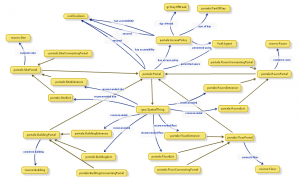 While Alex was off collecting data, Chris and I designed an ontology to describe entryways in linked data. It’s a lot harder than it sounds. To design our ontology we used Neologism, which is an excellent web-based tool for generating ontologies quickly, but the actual modelling process was where most of the work was. We opted for the umbrella term ‘portal’ as it nicely covers all possible entrances to things without explicitly stating entry or exit. A doorway is a portal, so indeed is a tunnel or a bridge. We also had disagreements as to whether or not security properties should be lumped together with access methods, and whether entrance/exit should be a property or a sub-class of the portal class. The task did get a bit serious once or twice as we started considering whether saying “Open Sesame” would count as an access method, and whether or not we should mention pre-1988 daleks in our description of a door with steps (we did.)
While Alex was off collecting data, Chris and I designed an ontology to describe entryways in linked data. It’s a lot harder than it sounds. To design our ontology we used Neologism, which is an excellent web-based tool for generating ontologies quickly, but the actual modelling process was where most of the work was. We opted for the umbrella term ‘portal’ as it nicely covers all possible entrances to things without explicitly stating entry or exit. A doorway is a portal, so indeed is a tunnel or a bridge. We also had disagreements as to whether or not security properties should be lumped together with access methods, and whether entrance/exit should be a property or a sub-class of the portal class. The task did get a bit serious once or twice as we started considering whether saying “Open Sesame” would count as an access method, and whether or not we should mention pre-1988 daleks in our description of a door with steps (we did.)
Once we had a way of representing the data, it was quite a simple task of writing a script to generate triples from Alex’s spreadsheet, and modifying the pages on data.southampton.ac.uk that describe buildings. Chris also built a smaller, hand-maintained file that lists common learning spaces such as lecture theatres, and which external door is the closest. This is now listed on the room pages, such as on this page about a lecture theatre in the Life Sciences building. Although they’re still lacking information on entry method and access restrictions, we now have a page for all the building external doors on campus that we know about, such as this page, about the south entrance to Building 2, which explains that the entrance has steps and is not easily accessible by people in wheelchairs.
Of course there are always things that don’t go to plan, and we need to learn more about certain things. One idea Chris had for getting latitude/longitude points of the doors was to leave the GPS on his phone on while taking photos of each door, and also take a photo of his feet stood next to each door with the intention of pulling the GPS information from the photo’s EXIF meta-data. This didn’t go as planned because the GPS on some phones isn’t very accurate, and although all of the geo-tagged photos were clearly on campus, many were next to the wrong building. We had plans to ask people to crowdsource spacial data by asking people to send us geo-tagged photographs, but this clearly won’t work.
The other thing we discovered is that RDF is a great way of representing this data because you can simply leave out the bits you don’t know. For example, there were several doors to which we don’t have access, and it’s not always obvious how a door opens unless you can actually open it. We were trying to list which doors require you to push or pull, which open with a push-button and which are on a sensor. It’s usually obvious which doors are on push-button, but unless you can actually see the door opening you can’t determine whether they’re manual or sensor-controlled. It doesn’t help that some things change based on time of day. For example, the doors on building 32 are sensor-controlled during the day, but become card access in the evening.
To conclude, it was another very beneficial WAIS Fest, as the output was not just a new, permanent feature for the Open Data website, but also we learned a lot about crowdsourcing, as well as the design of ontologies that describe something seemingly simple like doorways. The work we did will not just benefit lost students and members of staff, but will also hopefully benefit those with accessibility problems such as wheelchair users.
Running an Open Data stand at a University Open Day
September 10, 2013
by Ash Smith
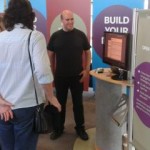 University open days are a great way for prospective students to find out about a university by seeing it for themselves. It gives the students – and their parents – a good idea of the campus, the area and the organisation, as well as giving them the chance to meet some of the staff. From the University’s point of view, open days are our chance to shine, in an attempt to convince our visitors that we’re the best place for them to spend three years of their lives.
University open days are a great way for prospective students to find out about a university by seeing it for themselves. It gives the students – and their parents – a good idea of the campus, the area and the organisation, as well as giving them the chance to meet some of the staff. From the University’s point of view, open days are our chance to shine, in an attempt to convince our visitors that we’re the best place for them to spend three years of their lives.
Many universities ‘do’ open data, but very few, if any, do it on the same scale as Southampton. We’re also the first university to actually employ someone full-time to work on open data. So we in the Open Data Service were quite keen to get ourselves a stand at the open day, as we genuinely believe that the data and tools we provide are a massive plus for students studying here. Now that the open days are over for the year, I thought I’d blog about my experiences running these stands. I learned a lot, so this blog post is mainly so I don’t forget these lessons, but also my contribution to other people who want to run similar stands at their own institutions.
The main obstacle I needed to overcome was the fact that I’m not a salesperson. Coming from a research background means I’m comfortable talking to a large captive audience, but I had never before tried to grab people ‘off the street’ and talk to them personally about something they’ve probably never heard of, particularly if they have other goals in mind. Our stand was in a room alongside the accommodation service, the financial support service and the careers advice stand, all things that prospective students will actively seek out at open days. These stalls were pulling massive crowds, while myself, Pat and Chris were lucky to get more than a handful of people at any one time. As the few people curious enough to approach us on their own accord all asked us the same question – “What is open data?” – I can only assume that we were always going to be at a disadvantage by simply being something of which most people are completely unaware. Running a stand promoting something so new really does require a very proactive approach.
We tried to choose a good set of demos that really showed off how open data can be used to benefit students, and I made a point of not going too much into the technical details, as in my experience this tends to scare people off. My aim was to always start with a good opening gambit such as “can I show you one of the perks of studying at Southampton?” Once I had an audience, I began by explaining in 20 seconds what the Open Data Service actually do. Then I showed the data in friendly, non-technical form with the help of Colin Williams’ excellent Open Data Map. Depending on who I was talking to I then went on to demo our new bus finder service, which we’ll be launching officially in time for Freshers’ Week, and then my workstation finder. This was particularly good on the Saturday because most of the rooms on campus were closed for the weekend and showing zero machines available. I explained to prospective students that this is a possible stumbling block if you have a deadline on Monday and need access to a computer, but not if you have our tools, as you can find an alternative computer quickly without having to go around looking for one. All this, I felt, was a good way of showing the usefulness of open data without actually getting too technical. Of course, throughout the day I occasionally got to talk to someone hoping to study computer science, meaning I could talk to them more frankly and tell them that all the data is available for them to hack something together themselves if they so wish.
Overall, it went very well. I spoke to lots of people, and even if I personally didn’t convince anyone to choose Southampton, I think a lot of people went home a bit more knowledgeable about the value of open data. I guess getting up early and coming in to work all weekend isn’t everyone’s idea of fun, but we’re all about mutual benefits and this was a chance to promote the University and open data at the same time, so we were completely happy to do this. It certainly wasn’t without its rewards, either. My personal highlight was on the Friday afternoon. I managed to get the attention of a prospective student, and I spent a few minutes showing her the tools we provide and explaining situations in which they would be useful. She ran over to her parents and actually dragged them away from one of the other stands before excitedly asking me to start again and show them everything I’d just showed her. I guess I did something right!
Open Data Open Day – Hackers summary
June 27, 2013
by Patrick McSweeney
As you know from Ash’s previous post ran an Open Data Open Day for people in the University to come and learn about open data. As part of the event we invited the University top hackers to come and do some open data hacking. The template is one familiar to many of you who have attended our events or JISC hack days before. Simply get hackers to sit down together, form into teams of 2-5 people, give them a blank slate, float some ideas, keep coffee on tap and periodically wheel food in and out. At the end of the day go to the bar so that each team can present what they have been working on over a hard earned beer.
One of the key aims for the day was to link up people who had data with people who could do something cool with it. The hack day is a good way to do this because you have a room full of people who can do something cool. Then over the course of the day people with data drop by and talk to the hackers, tell them about there data and get ideas to do cool stuff. It is a friendly and informal environment to work in and people come out with some really good ideas. What always surprises me is, even though I have participated in at least 30 and run at least 5, the outputs from the day are always so amazing good. This hack day was no exception and our teams came out with a combination of the awesomely cool and mind-bogglingly useful stuff.
The outputs were:
LOD Search and the data.southampton.ac.uk usability study
Collin Williams (CISCO Systems) , Rikki Prince, Biscuits Newton and Andreas Galazis Decided the usability of data.southampton.ac.uk was not good enough for non-technical people. They performed a usability study of the site and identified key areas of weakness to feed back to us. The biggest problem they found was that the search on data.southampton was nearly unusable. To combat the problem they created LOD Search, a SPARQL smart search indexing tool which can generate a usual search engine on any SPARQL end point. The demo they presented was very very impressive and prompted a lot of questions from the audience. Attempts to trip up the system by asking for difficult things gave it no trouble at all and the interface was surprisingly good given the short time available to work on it.
Adam Field (iSolutions), Matt Smith (iSolutions) and Lisha Chen-Wilson (iSolutions) met Adam Tewksbury from the University transport office. He was looking for a cool map and video of cycle routes which he can embed in the transport website and attach to the open data pages and maps. The team took helmet cam videos and GPS data about the route and combined them to make cool video which moves the pointer on an open street map as the the video plays. The technique is very powerful and reproducible for any combination of video and GPS data in KML or CSV format. Hopefully this will result in more students and staff getting on to their bikes to cycles the safe routes of Southampton.
Exchange Calendar to iCal
Martin Chivers (iSolutions) spent a chunk of the morning in talks learning about the nuts and bolts of open data. In the afternoon he grabbed a laptop and cracked really big data.southampton.ac.uk walnut. He created a commandline tool which exports a exchange calendar as iCal. One of our big bug bears in open data has been getting data out of exchange and this tool hit the problem squarely on the head. In the past we have had to ask users with temporal data to set up an account on Google calendar since we can get data out of it but not from our own exchange server. Now users will be able to work in their normal workflow without having to use a tool outside of the University to do a fair ordinary task. As a demo he was kind enough to give us the iSolution change management calendar as open data.
Exchange Calendar to iCal on github
Southampton Blackout the real story
Tyler Ward (ECS) was more of a victim of circumstance than a hacking volunteer at our Hack Day. He was collocated with us to work on ECS’s media sensation Erica the Rhino but since he is keen got caught up in the open data hackery. The University of Southampton ran a media campaign called the Southampton Blackout to promote efficient power use at the University. The write up from our Comms team had some interesting mathematical inaccuracies which made the integrity of the finds questionable. Tylers aim was to use open energy usage data to tell the real story of the Southampton blackout. What he found is that some buildings during the blackout were using more energy not less to a level which almost eclipses the savings made in other buildings. He found some interesting trends in the data particularly in the figure below for ECS Mountbatten Silcon Fab lab. His close analysis of data was able to deduce where future campaigns should be targeting next an where savings can be made most easily.
All in all the day was a great success and lots of fun for the hackers involved. To quote Adam Field:
I had fun. It’s not often that I can take a problem and spend a day solving it.
Open Data Open Day – Summary
June 27, 2013
by Ash Smith
Yesterday, 26th June, we held the University’s first ever ‘Open Data Open Day’. This was a day organised by the Open Data service to show the wider university community exactly what linked and open data can do for them. The University has recently announced that open data, specifically an ‘open by default’ attitude, is to be a core principle of its strategy for at least the next five years, so we decided to concentrate our open day on non-technical staff, who may not appreciate what this entails, while at the same time holding a hack event in the building 32 coffee room for anyone with programming knowledge.
We had three main objectives for the day.
- To raise the profile of Open Data to the non-technical members of the university.
- To connect people who have data with people who can do cool stuff with data.
- To come up with some cool demos that show off the power of Open Data.
The day was a success. I ran an introductory talk early in the day, which was well-attended and concluded with an extended question and answer session and a positive response. Pat and I later presented a ‘show and tell’ of all the cool features we’ve been working on that show the power of linked open data, and I followed this up by giving a talk based on my last blog post on good data practice. All the time the talks were going on, several teams of hackers were hard at work in the next room, building some tools and demos using our data. They presented their work at the end of the day in the Terrace Restaurant, each with a well-earned pint. Patrick has written a more detailed post explaining what they got up to.
We also had two guest speakers – Cassie Robinson from Londonscape, a large civic project that uses data from four wards of a London borough, and Sina Samangooei from WAIS, who talked about streamed reasoning to an audience consisting mainly of hackers fresh from their presentations, ensuring a lively discussion.
Because of the success of the event, we plan to run something like this again, possibly in term time in order to get a feel for how students see Open Data.
Open Data Hack-around day
May 22, 2013
by Christopher Gutteridge
When: June 26th, 10am-5pm
Where: Access Grid room, Level 3, Building 32 (and probably also the Level 4 coffee room for less formal stuff)
The data.southampton team will be hosting a hackaround day where we’ll give demos, take ideas, help you use the data and build neat things. The exact format of the day will be very loose, but anybody interested is welcome to drop in and have a chat, watch a demo or meet other interested people to start developing ideas and new uses.
If you’re definitely/possibly coming, you can indicate it on the facebook page for the event.
Got some requests or ideas already? Leave them in the comments.

